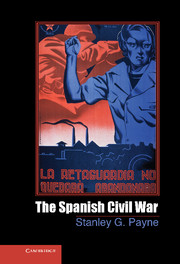Book contents
- Frontmatter
- Contents
- Chronology of Major Events
- Glossary
- Preface
- Introduction Civil War in Twentieth-Century Europe
- 1 Modernization and Conflict in Spain
- 2 From Revolutionary Insurrection to Popular Front
- 3 The Breakdown of Democracy
- 4 The Military Insurrection of the Eighteenth of July
- 5 The Battle of Madrid – the First Turning Point
- 6 Revolution
- 7 Terror
- 8 A War of Religion
- 9 Franco's Counterrevolution
- 10 Foreign Intervention and Nonintervention
- 11 Soviet Policy in Spain, 1936–1939
- 12 The Propaganda and Culture War
- 13 A Second Counterrevolution? The Power Struggle in the Republican Zone
- 14 The Decisive Northern Campaigns of 1937–1938
- 15 The War at Sea and in the Air
- 16 Civil Wars within a Civil War
- 17 The War in Perspective
- Conclusion Costs and Consequences
- Select Bibliography
- Index
- References
4 - The Military Insurrection of the Eighteenth of July
Published online by Cambridge University Press: 05 September 2012
- Frontmatter
- Contents
- Chronology of Major Events
- Glossary
- Preface
- Introduction Civil War in Twentieth-Century Europe
- 1 Modernization and Conflict in Spain
- 2 From Revolutionary Insurrection to Popular Front
- 3 The Breakdown of Democracy
- 4 The Military Insurrection of the Eighteenth of July
- 5 The Battle of Madrid – the First Turning Point
- 6 Revolution
- 7 Terror
- 8 A War of Religion
- 9 Franco's Counterrevolution
- 10 Foreign Intervention and Nonintervention
- 11 Soviet Policy in Spain, 1936–1939
- 12 The Propaganda and Culture War
- 13 A Second Counterrevolution? The Power Struggle in the Republican Zone
- 14 The Decisive Northern Campaigns of 1937–1938
- 15 The War at Sea and in the Air
- 16 Civil Wars within a Civil War
- 17 The War in Perspective
- Conclusion Costs and Consequences
- Select Bibliography
- Index
- References
Summary
From the beginning of the Republic in 1931, both the extreme left and extreme right had conspired against it, but in the first years neither was important. Ultra-right-wing monarchists, erstwhile supporters of the former king Alfonso XIII known as “alfonsinos,” began to conspire almost as soon as the monarchy collapsed, while the Republic's religious persecution stimulated the reemergence of their rivals, the traditionalist monarchists or Carlists, whose origins lie early in the nineteenth century. Few monarchists, however, were willing to become directly involved, so that the abortive rebellion of General José Sanjurjo in August 1932 gained success in only one garrison (Seville) and quickly collapsed, enjoying less support than any of the three anarchist insurrections.
Founding of the monarchist journal Acción Española first provided a new theoretical basis for what was termed the instauración, not restoration, of a new kind of neotraditional, Catholic, and corporative-authoritarian monarchy, but the alfonsino political party, Renovación Española, was never able to generate much support. The two monarchist groups, the Carlist Comunión Tradicionalista and Renovación Española, together could scarcely draw as much as 10 percent of the vote. After the partial victory of the CEDA in the elections of 1933, the extreme right despaired of its own strength and turned to Mussolini's Italy, signing an agreement with the Italian government on March 31, 1934, which was to provide Italian financial support, military training facilities, and a limited amount of weapons to assist an eventual monarchist revolt in Spain. The very need to look abroad was evidence of the weakness of this conspiracy, which predictably produced nothing and by the following year had become a dead letter.
- Type
- Chapter
- Information
- The Spanish Civil War , pp. 64 - 81Publisher: Cambridge University PressPrint publication year: 2012



